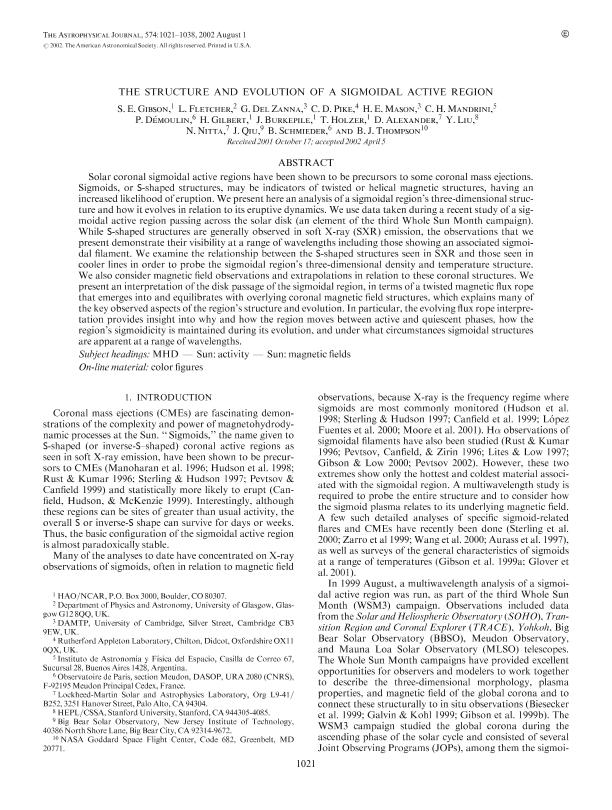Mostrar el registro sencillo del ítem
dc.contributor.author
Gibson, S. E.
dc.contributor.author
Fletcher, L.
dc.contributor.author
Del Zanna, G.
dc.contributor.author
Pike, C. D.
dc.contributor.author
Mason, H. E.
dc.contributor.author
Mandrini, Cristina Hemilse

dc.contributor.author
Démoulin, Pascal

dc.contributor.author
Gilbert, H.
dc.contributor.author
Burkepile, J.
dc.contributor.author
Holzer,T.
dc.contributor.author
Alexander, D.
dc.contributor.author
Liu, Y.
dc.contributor.author
Nitta, N.
dc.contributor.author
Qiu, J.
dc.contributor.author
Schmieder, B.
dc.contributor.author
Thompson, B.
dc.date.available
2017-08-15T15:03:24Z
dc.date.issued
2002-08
dc.identifier.citation
Gibson, S. E.; Fletcher, L.; Del Zanna, G.; Pike, C. D.; Mason, H. E.; et al.; The Structure and Evolution of a Sigmoidal Active Region; IOP Publishing; Astrophysical Journal; 574; 2; 8-2002; 1021-1038
dc.identifier.issn
0004-637X
dc.identifier.uri
http://hdl.handle.net/11336/22447
dc.description.abstract
Solar coronal sigmoidal active regions have been shown to be precursors to some coronal mass ejections. Sigmoids, or S-shaped structures, may be indicators of twisted or helical magnetic structures, having an increased likelihood of eruption. We present here an analysis of a sigmoidal region´s three-dimensional structure and how it evolves in relation to its eruptive dynamics. We use data taken during a recent study of a sigmoidal active region passing across the solar disk (an element of the third Whole Sun Month campaign). While S-shaped structures are generally observed in soft X-ray (SXR) emission, the observations that we present demonstrate their visibility at a range of wavelengths including those showing an associated sigmoidal filament. We examine the relationship between the S-shaped structures seen in SXR and those seen in cooler lines in order to probe the sigmoidal region´s three-dimensional density and temperature structure. We also consider magnetic field observations and extrapolations in relation to these coronal structures. We present an interpretation of the disk passage of the sigmoidal region, in terms of a twisted magnetic flux rope that emerges into and equilibrates with overlying coronal magnetic field structures, which explains many of the key observed aspects of the region´s structure and evolution. In particular, the evolving flux rope interpretation provides insight into why and how the region moves between active and quiescent phases, how the region´s sigmoidicity is maintained during its evolution, and under what circumstances sigmoidal structures are apparent at a range of wavelengths.
dc.format
application/pdf
dc.language.iso
eng
dc.publisher
IOP Publishing

dc.rights
info:eu-repo/semantics/openAccess
dc.rights.uri
https://creativecommons.org/licenses/by-nc-sa/2.5/ar/
dc.subject
Magnetohydrodynamics
dc.subject
Solar Activity
dc.subject
Solar Magnetic Fields
dc.subject.classification
Astronomía

dc.subject.classification
Ciencias Físicas

dc.subject.classification
CIENCIAS NATURALES Y EXACTAS

dc.title
The Structure and Evolution of a Sigmoidal Active Region
dc.type
info:eu-repo/semantics/article
dc.type
info:ar-repo/semantics/artículo
dc.type
info:eu-repo/semantics/publishedVersion
dc.date.updated
2017-08-11T14:57:56Z
dc.journal.volume
574
dc.journal.number
2
dc.journal.pagination
1021-1038
dc.journal.pais
Reino Unido

dc.journal.ciudad
Londres
dc.description.fil
Fil: Gibson, S. E.. National Center for Atmospheric Research; Estados Unidos
dc.description.fil
Fil: Fletcher, L.. University of Glasgow; Reino Unido
dc.description.fil
Fil: Del Zanna, G.. University of Cambridge; Reino Unido
dc.description.fil
Fil: Pike, C. D.. Rutherford Appleton Laboratory; Reino Unido
dc.description.fil
Fil: Mason, H. E.. University of Cambridge; Reino Unido
dc.description.fil
Fil: Mandrini, Cristina Hemilse. Consejo Nacional de Investigaciónes Científicas y Técnicas. Oficina de Coordinación Administrativa Ciudad Universitaria. Instituto de Astronomía y Física del Espacio. - Universidad de Buenos Aires. Facultad de Ciencias Exactas y Naturales. Instituto de Astronomía y Física del Espacio; Argentina
dc.description.fil
Fil: Démoulin, Pascal. Centre National de la Recherche Scientifique. Observatoire de Paris; Francia
dc.description.fil
Fil: Gilbert, H.. National Center for Atmospheric Research; Estados Unidos
dc.description.fil
Fil: Burkepile, J.. National Center for Atmospheric Research; Estados Unidos
dc.description.fil
Fil: Holzer,T.. National Center for Atmospheric Research; Estados Unidos
dc.description.fil
Fil: Alexander, D.. Lockheed-Martin Solar and Astrophysics Laboratory; Estados Unidos
dc.description.fil
Fil: Liu, Y.. University of Stanford; Estados Unidos
dc.description.fil
Fil: Nitta, N.. Lockheed-Martin Solar and Astrophysics Laboratory; Estados Unidos
dc.description.fil
Fil: Qiu, J.. New Jersey Institute Of Technology; Estados Unidos
dc.description.fil
Fil: Schmieder, B.. Centre National de la Recherche Scientifique. Observatoire de Paris; Francia
dc.description.fil
Fil: Thompson, B.. National Aeronautics and Space Administration. Goddart Institute for Space Studies; Estados Unidos
dc.journal.title
Astrophysical Journal

dc.relation.alternativeid
info:eu-repo/semantics/altIdentifier/url/http://iopscience.iop.org/article/10.1086/341090
dc.relation.alternativeid
info:eu-repo/semantics/altIdentifier/doi/http://dx.doi.org/10.1086/341090
Archivos asociados
